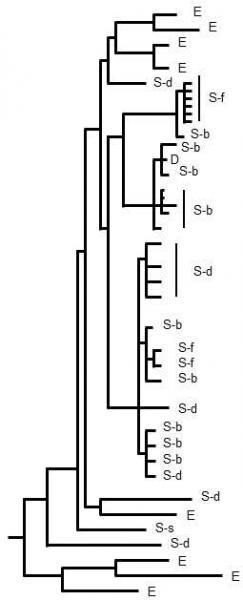XX.3.1.3 Typological species need not necessarily be monophyletic
Most of the definitions of species require that the individual species be monophyletic, i.e. that they be formed in evolution through a unique speciation event.The definition of a typological species, at least in principle, does not entail this limiting requirement.A taxonomist usually considers that a separate species corresponds to a line of organisms that differ from other similar lines in an important phenotype trait.However, what an important phenotype trait consists in is often a matter of the subjective opinion of the scientist.Frequently, a quite inconspicuous trait is chosen, whose presence or absence has some sort of importance for humans.Amongst bacteria, this trait frequently consists in the ability to cause a certain disease or cause a certain symptom of a disease.As the genetic basis for such a trait in the individual lines of organisms need not be very complicated, its occurrence need not be correlated with the overall relatedness of these lines.For example, intestinal bacteria of the closely related species Escherichia coli, which exhibits pathogenic activity for humans, is frequently included under the bacterial genus Shigella. The genus was defined primarily on the basis of its pathogenicity; however, immobility and the inability to cause fermentation of glucose are used as diagnostic traits.In time, it was found that these traits need not always be correlated with the pathogenicity of these bacteria.Consequently, a great many pathogenic strains of Escherichia coli are now known.Molecular taxonomy studies later demonstrated that the genus Shigella is apparently polyphyletic and that its individual lines are variously scattered throughout the phylogenetic (more precisely genealogical) tree of the species E. coli (Pupo, Lan, & Reeves 2000)(Fig. XX.6).

Fig. XX.6 Repeated formation of the Shigella genus within the Escherichia coli species. The phylogenetic tree of bacteria of the Escherichia (E) and Shigella (S) genera was drawn up by a distance method on the basis of similarity of sequences of eight genes. It is apparent from the typology of the tree that the Shigella genus is polyphyletic, i.e. that its strains evolved repeatedly at various places in the phylogenetic tree of the E. coli species. Individual species of the Shigella genus (S. bodii, S. dysenteriae, S. flexneri and S. sonnei) were delimited and their members were determined on the basis of classical microbiological methods, i.e. using biochemical data. Modified according to Pup et al. (2000).
